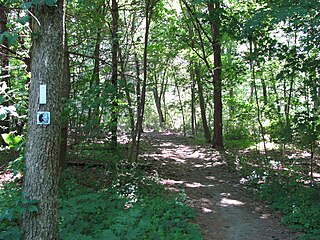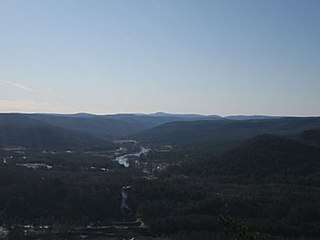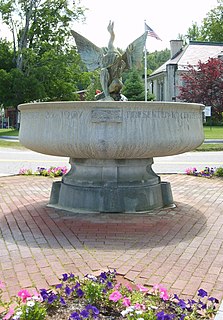
The National Audubon Society (Audubon) is a non-profit environmental organization dedicated to conservation. Located in the United States and incorporated in 1905, Audubon is one of the oldest of such organizations in the world and uses science, education and grassroots advocacy to advance its conservation mission. It is named in honor of John James Audubon, a Franco-American ornithologist and naturalist who painted, cataloged, and described the birds of North America in his famous book Birds of America published in sections between 1827 and 1838.
The Paul J. Rainey Wildlife Sanctuary is a 26,000-acre (110 km2) refuge owned by the National Audubon Society in Vermilion Parish, Louisiana. Established in 1924, this private Louisiana sanctuary is home to alligator, deer, muskrat, otter, geese and many other species. Because of the focus to maintain safe, secure and healthy habitats for waterfowl and other endemic wildlife, it is not open to the public, and no hunting or fishing is permitted within the Sanctuary boundaries. There are no roads to the Sanctuary, and boat access through the private canals is by permission only. It is currently managed by Audubon Louisiana, a state office of the National Audubon Society.
The Connecticut Audubon Society Coastal Center at Milford Point is a nature center and bird sanctuary in Milford, Connecticut, established in 1995. Over 300 different species of bird have been observed at this location. The Coastal Center is located on an 8.4-acre (34,000 m2) barrier beach—the Smith-Hubbell Wildlife Refuge & Bird Sanctuary—and is situated next to the 840-acre (3.4 km2) Charles Wheeler Salt Marsh and Wildlife Management Area at the mouth of the Housatonic River. The Coastal Center provides easy access to Long Island Sound and its many habitats: tidal salt marshes, barrier beaches, tide pools and coastal dunes, and utilizes these habitats for environmental education for youth and adults. These various environments and habitats support a variety of bird, plant and animal communities for observation and study. The Coastal Center also contains educational exhibits and live animals.

The Daniel Webster Wildlife Sanctuary is a sanctuary owned by the Massachusetts Audubon Society, the largest conservation organization in New England, in the town of Marshfield, Massachusetts. The sanctuary, formerly the farm of Edward Dwyer, statesman Daniel Webster and the William Thomas family of Marshfield, the first English landowner to live on the sanctuary land, was purchased by Mass Audubon in 1984 thanks to the volunteer efforts of the Committee for the Preservation of Dwyer Farm for the People of Marshfield. The sanctuary contains 507 acres (2.1 km2) of mixed cultural grasslands, red maple swamps, a five-tiered wet panne, Webster Pond and a section of the Green Harbor River. It is the site of the annual Daniel Webster Farm Day celebration. Surrounding lands owned by the town of Marshfield and the Marshfield Airport increase the local open space area to more than 1000 acres (4 km2).

The North River Wildlife Sanctuary is a wildlife sanctuary owned by the Massachusetts Audubon Society, the largest conservation organization in New England, in the town of Marshfield, Massachusetts. The sanctuary contains 184 acres (0.74 km2) of mixed cultural grasslands, red maple swamps, oak-pine woodland and access to the North River. The North River Wildlife Sanctuary came to Mass Audubon as a gift of the Killam and Rodgers families in 1977.

The Massachusetts Audubon Society, founded in 1896 by Harriet Hemenway and Minna B. Hall, headquartered in Lincoln, Massachusetts, is a nonprofit organization dedicated to "protecting the nature of Massachusetts". Mass Audubon is independent of the National Audubon Society, and was founded earlier. Mass Audubon protects 36,500 acres of land throughout Massachusetts, saving birds and other wildlife, and making nature accessible to all with its wildlife sanctuaries and 20 nature centers.

The Ipswich River Wildlife Sanctuary, which is the Massachusetts Audubon Society’s largest wildlife sanctuary, is located in Topsfield and Wenham, Massachusetts. Much of its 2,800-acre (11 km2) landscape was created by a glacier 15,000 years ago.

The Connecticut Audubon Society Birdcraft Museum and Sanctuary, also known as Birdcraft Museum & Sanctuary or simply Birdcraft Sanctuary, in Fairfield, Connecticut is the oldest private songbird sanctuary in the United States. It was established in 1914 by Mabel Osgood Wright.
Hog Island is an island spanning 330 acres (130 ha) located in Muscongus Bay in Bremen, Maine at the end of Keene Neck Road. It is a part of the Todd Wildlife Sanctuary, which includes an additional 30 acres (12 ha) on the mainland across from the island, as well as the current home to the Audubon Camp in Maine operated by the Seabird Restoration Program of the National Audubon Society.

The Bay Circuit Trail and Greenway or Bay Circuit is a Massachusetts recreational trail and greenway connecting the outlying suburbs of Boston from Plum Island in Newburyport to Kingston Bay in Duxbury, a distance of 200 miles (320 km).

The High Ledges is a wildlife sanctuary located in Shelburne, Massachusetts. The 587-acre (2.38 km2) property, located on the northern portion of Massaemett Mountain, is owned by Massachusetts Audubon Society.

The Connecticut Audubon Society Center at Fairfield is a nature center and wildlife sanctuary in the Greenfield Hill area of Fairfield, Connecticut. Constructed in 1971, the center features classrooms for environmental education programs, live animals on display, natural history exhibits, a nature library, a solar greenhouse and a gift shop. Outside there is a compound with non-releasable rescued birds of prey, including owls, hawks, peregrine falcons, a turkey vulture and other raptors.

The Audubon Society of Portland is a non-profit environmental organization dedicated to wildlife conservancy in Portland, Oregon, United States.
Sampsons Island is a 15-acre (6.1 ha) uninhabited, undeveloped barrier island at the mouth of Cotuit Harbor in Barnstable, Massachusetts. It is the location of the Massachusetts Audubon Society's Sampsons Island Wildlife Sanctuary, and it forms part of the Sampsons Island/Dead Neck Island barrier beach system. The island is only accessible by private boat, and is used for recreation and wildlife viewing and preservation.

The Connecticut Audubon Society, founded in 1898 and headquartered in Fairfield, Connecticut, is a nonprofit organization dedicated to "conserving Connecticut’s environment through science-based education and advocacy focused on the state’s bird populations and habitats." Connecticut Audubon Society is independent of the National Audubon Society.

The San Joaquin Wildlife Sanctuary is a 300 acres constructed wetland in Irvine, California, in the flood plain of San Diego Creek just above its outlet into the Upper Newport Bay.

Willard Pond is a small, protected lake in Antrim, New Hampshire, United States. The lake, located in southwestern New Hampshire, is about 108 acres (44 ha) in size with an average depth of 25 feet (7.6 m) and a maximum depth of 58 feet (18 m). No petroleum motors are allowed, and fly fishing is the only form of fishing allowed. It is part of the dePierrefeu Wildlife Sanctuary, which is owned by the New Hampshire Audubon Society. Because the pond and the land around it are part of the sanctuary, the shore is unable to be developed. Therefore, there are no buildings around the pond and there won't be in the foreseeable future. Willard is instead surrounded by extensive amounts of wilderness and hiking trails that lead around the pond and to the summits of Bald Mountain and Goodhue Hill. Willard is a popular fishing, boating and hiking destination, and it has become more popular with its mention in numerous magazines and newspapers.

The Edith L. Moore Nature Sanctuary is a 17.5-acre nature sanctuary along Rummel Creek, located in Houston, Texas, in the United States. Named after Edith Lotz Moore, who lived on the land with her husband for 43 years, the sanctuary includes a restored log cabin for hosting educational programs and houses administrative offices for the Houston Audubon Society. Since 1975, Houston Audubon has preserved Edith Moore's log cabin in addition to developing trails, creating education programs, constructing an office, and performing outreach from the site. The sanctuary also operates a plant nursery that provides wildflowers and grasses for coastal prairie restoration projects or offered for sale to support the Audubon programs. It specializes in local native prairie grasses and wildflowers with a small selection of understory plants. Moore donated land to the Houston Audubon Society in 1975, to be used as a nature preserve for birds. According to the Houston Audubon Society, the sanctuary's mission is to "provide an urban wildlife sanctuary for native plants and animals and to provide education about the natural environment to Houstonians of all ages." Birding programs and day camps held at the sanctuary serve more than ten thousand children and adults every year. This trail is accessible from 7am-7pm.
Stony Brook Wildlife Sanctuary is a wildlife sanctuary in Norfolk, Massachusetts. It is among a network of sanctuaries with the Massachusetts Audubon Society. The 104-acre sanctuary is adjacent to the 140-acre Bristol Blake State Reservation. Both areas are managed by the Department of Conservation and Recreation (DCR). An easy 1 mile (1.6 km) trail starts around by encircling Stony Pond and ends by a waterfall at the site of a former mill. It is wheelchair accessible. The trail includes a 525-foot long boardwalk, installed in 2017, that allows visitors to view birds, wildlife, and the wetland habitat over Teal Marsh and Kingfisher Pond. Wildlife found at there include turtles, ducks, geese, great blue herons, and muskrats. The sanctuary also has natural history exhibits, programming space, a gift shop, nature play area, a picnic area, and a butterfly garden.
Minna B. Hall was an American socialite and environmentalist. Her most notable achievements include the formation of the Massachusetts Audubon Society and the ratification of the Weeks-McLean Act by the US Congress. Together with her cousin, Harriet Lawrence Hemenway, Hall organized ladies' teas at which she urged women to stop wearing hats with feathers. Hall's boycott of the fashion of wearing plumes ultimately changed the future of the American feather trade, and her activism remains a key event in the history of ornithological conservation.















